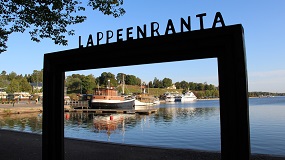Lappeenranta has been chosen as one of the finalists in the competition for the European Green Leaf Award 2021. The Finnish climate capital is a finalist for the second time in a row.
Lappeenranta has the best starting points before the finals in Lisbon on 7–8 August. The other finalists this year are the city of Gabrovo from Bulgaria and Elsinore, Nyborg and Ringkøbing-Skjern from Denmark.
The European Green Leaf Award is the European Commission's annual competition for cities with a population of 20,000 to 100,000, demonstrating commitment, progress and excellence in climate issues. The winners of the competition will act as climate ambassadors, sharing information on sustainable urban development and their own best practices.
“We in Lappeenranta entered this prestigious competition because we have done a lot of environmental and climate work making us able to carry the title of the greenest city in Europe. We have learned from last year’s competition and communication, for example, is playing an increasingly important role this year. More important than the title is that the knowledge about our own climate solutions is spreading widely, benefiting other cities in the world as well,” says Heli Mälkiä, spokesperson for the City of Lappeenranta in the European Green Leaf competition.
Goals and strong commitment
The winner of the European Green Leaf Award is required to adhere to high climate standards and to commit to ambitious future climate goals. Lappeenranta's climate goals are concretised, for example, in the city’s strategy and in the current and ongoing climate programme.
“Residents have also wanted to be involved in the preparation of the new climate programme as everyone's input is needed to achieve the climate goals. The residents of the municipality have excitedly joined the workshops to come up with ideas, and they have also been very interested in what they can do for the city's emission reductions,” says Mälkiä.
One of Lappeenranta's most important and ambitious goals is to be carbon neutral by 2030. Between 1990 and 2017, Lappeenranta's carbon dioxide emissions have decreased by 46 per cent. Today, all of the city's operating electricity is certified carbon-neutral electricity, and 70 per cent of Lappeenranta's district heating is produced carbon-neutral by the by-products of the forest industry. So much has already been achieved, but more climate work is still needed to achieve the goals.
Lots of deeds to promote green growth

© Minna Kivistö/City of Lappeenranta
The European Green Leaf Award recognises practical solutions to promote sustainable urban development. The city of Lappeenranta invests in sustainable development, circular economy and renewable energy with an emphasis on actions and results.
Lappeenranta coordinates the Greenreality Network, which includes fifty actors from the South Karelia region. The network creates growth and new business opportunities for the entire region’s energy and environmental sectors. Numerous environmental projects are also underway in Lappeenranta, several of which involve the LUT University especially known for its energy and environmental work.
A current example of innovative climate action is the new biogas plant at Kukkuroinmäki processing centre in Lappeenranta. It is Finland's first dry digestion plant. Local biowaste and sewage sludge are used as raw material. Biomethane produced in the biogas plant is a completely renewable, domestic, and emission-free alternative to foreign fossil fuels.
Sustainable development education for children
Lappeenranta is also among the exemplary pioneers in disseminating sustainable development know-how. LUT Junior University provides sustainable development education to 3,000 children and young people every year. The aim is to increase interest in science and university studies in accordance with the principles of sustainable development.
“The unique collaboration model is also of interest to the world, and Junior University has gained international media visibility. In addition, ISCN (International Sustainable Campus Network) awarded Junior University in the spring as the best cooperation model of 2020,” says Mälkiä.
More information